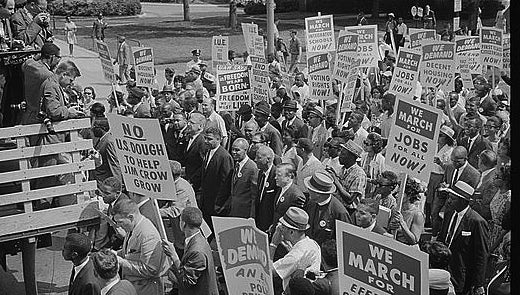
One of history’s many civil rights marches on Washington, D.C.
A lot has changed in the United States since the 1960s and 1970s. In those days, everything was about rebellion, right down to what the rebels wore. Turtleneck sweaters were a protest against neckties. Tie-die shirts signaled nonconformity. Bra burning was one small step for womankind. Bell-bottom pants were probably a social statement, too, but nobody seems to know what it was.
More importantly, children of the baby boom rebelled against materialism by moving from suburbs back to the land or joining the Peace Corps. They rebelled against racism, sexism and the Vietnam War. It was not only the Age of Aquarius; it was also the Age of Activism.
Environmental stewardship was on the agenda, too, but with greater collaboration from some of our presidents and congresses. In 1965, the President’s Science Advisory Committee suggested that environmental quality was every citizen’s right. In 1969, Congress passed the National Environmental Policy Act “to create and maintain conditions under which man and nature can exist in productive harmony.”
One draft of the Act included this more detailed statement:
The Congress recognizes that each person has a fundamental and inalienable right to a healthy environment and that each person has a responsibility to contribute to the preservation and enhancement of the environment.
That language did not make it into the Act, not because members of the House and Senate disagreed with it, but because they worried that the statement was too vague and would result in an avalanche of litigation.
Unfortunately, some of the most important struggles of the ’60s and ’70s are still underway, notably the fights for civil rights, equal rights and proactive environmental stewardship. An estimated 40,000 people marched in New York City in 2014 to call for federal climate action. Dedicated climate activists including celebrities have engaged in civil disobedience and gone to jail.
Things seemed to be going well pretty until last January when Donald Trump assumed the presidency. As though driven by a strange compulsion to destroy everything Barack Obama accomplished, Trump immediately began laying waste to Obama’s climate action plan, federal climate science and the Environmental Protection Agency. In response, tens of thousands turned out across the country last April to oppose what Trump was doing. Hundreds of climate activists, scientists and trade union members protested outside the White House after Trump announced his withdrawal from the Paris climate accord.
These demonstrations have caused more than a few flashbacks among those who were gassed, beaten and jailed in the 1960s. Today’s protests have affirmed that the spirit of justified rebellion is still alive in America. However, the climate rebellion needs to reach the intensity we experienced back when hardly a day went by without demonstrations in the streets and on campus nationwide. There is a critical difference between occasional rebellion and relentless rebellion.
Voters have to be enlisted, too. The carbon cartel would not have so much influence over Congress and the White House if more Americans voted the convictions they express to pollsters. Virtually every survey finds that although Democrats are more likely than Republicans to support environmental protection, a decisive majority of all voters wants a cleaner environment, renewable energy and climate leadership. But so far, voters have not punished the leaders who remain silent about climate change or who actively shill for the carbon cartel. The tipping point in government policy will come when politicians are more afraid of their constituents than they are afraid of the cartel.
For an effective climate rebellion, it’s also important to understand that the contemporary environmental challenge has more than one dimension. It involves taking back control of democracy. It has been subverted by unprincipled partisanship and the special interests empowered by the Supreme Court’s mind-boggling ruling that corporations are people and have the right to shower political campaigns with cash. It involves a deliberate transition to an economy powered mostly, if not entirely, by carbon-free renewable energy. And it involves a fundamental change in our understanding of our relationship with natural systems.
In a study published by the National Academy of Sciences two years ago, a group of researchers drilled into the core of this last challenge. They noted a “a fundamental asymmetry” in which our focus on short-term production and consumption leads to a loss of the natural capital necessary for our long-term well-being.
“The central challenge of the 21st century,” they wrote,
is to develop economic, social, and governance systems capable of ending poverty and achieving sustainable levels of population and consumption while securing the life-support systems underpinning current and future human well-being...Sustainable development in the 21st century requires explicit recognition that social and economic development are part of—and dependent upon—a stable and resilient biosphere.
We know today that material progress and environmental protection are not mutually exclusive. A growing number of nations and communities are proving it by decoupling economic development from energy consumption and greenhouse gas emissions.
To sum up, there is no shortage of important social, economic and political issues to work on today, but none is more important than minimizing the likelihood of irreversible climate disruption. There is no mystery about what we must do. We must stop putting greenhouse gases into the atmosphere by transitioning to a clean energy economy. Instead, we are witnessing a profound tragedy in the United States as Trump and Congress reverse years, perhaps generations, of environmental progress.
We need citizen rebellion to be relentless again and to maintain its moral authority with disciplined nonviolence. The ’60s and ’70s showed that rebellion succeeds only when leaders are convinced it won’t go away. A half century ago, there was rarely a day when demonstrations were not underway in the streets and on campuses around the country. Protests against the Vietnam war persisted for nine years before the war ended.
We don’t have a military draft today to drive people into the streets, but everyone alive and yet to be born is being conscripted by the carbon cartel into an ugly future. In the final analysis, it makes little difference what Congress and its laws say; moral law requires that we rise up against the people who are profiting from the pollution that’s changing the climate and against the people like Trump and his team who are aiding and abetting this crime.
We need to ask ourselves on this and other injustices whether we are still capable of the sustained moral force and momentum that changed the course of government in the 1960s. Or did the spirit of bell-bottom pants and turtleneck sweaters?
